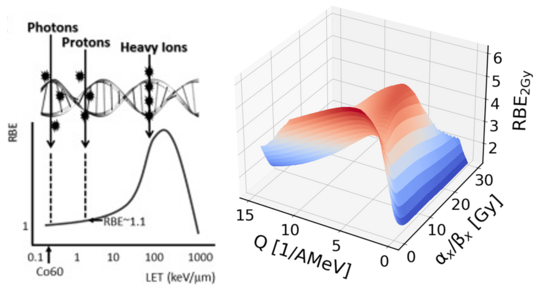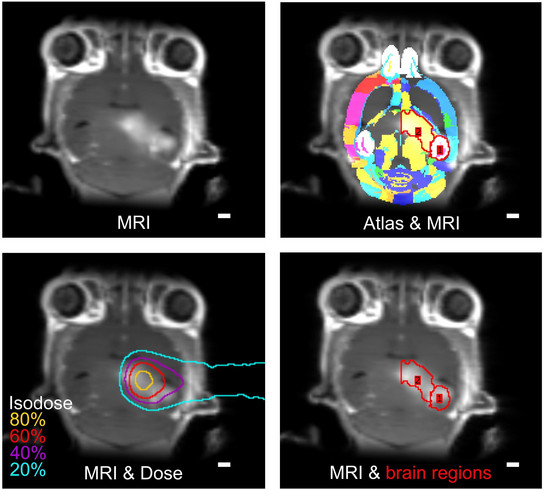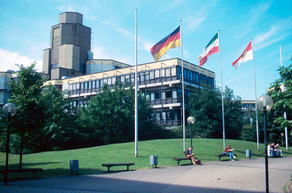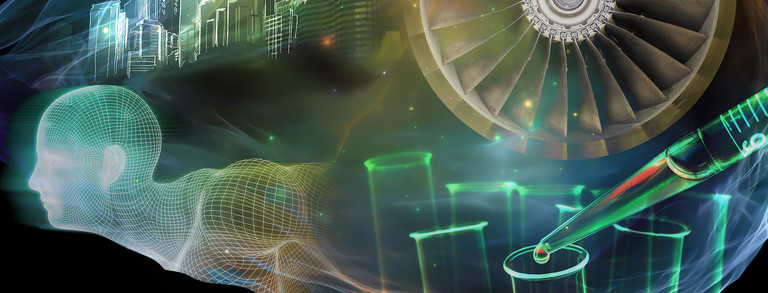Biological effect of radiation
The second main research focus of our working group is the biological effect of radiation. This area of study is crucial for understanding the underlying mechanisms through which proton radiation impacts biological tissues, which in turn informs the optimization of therapeutic strategies. Our research in this domain includes the development of refined prediction models for the variable effective radiation dose. One subproject focuses on examining the cellular processes that lead to radiation-induced brain injury based on an in vivo mouse model, providing insights into the pathophysiological changes and potential therapeutic interventions. By elucidating these complex interactions, we aim to enhance the efficacy and safety of proton therapy, ultimately improving patient outcomes and advancing the field of radiobiology.
Overview
One click will take you directly to the short description of the particular research project:
Biological effect of radiation at the cellular level
Relative biological effectiveness (RBE) in clinical proton therapy
In vivo analysis of cellular processes causing radiation-induced brain injury
Biological effect of radiation at the cellular level
The irradiation of cells provides the ideal framework to better understand the fundamental biological effects of ionising radiation and to investigate their essential dependencies. This project focuses on improving the conventional modelling of the biological effectiveness of proton and ion beams, e.g. by applying modern modelling methods. The ultimate goal of this project is the improved modelling of clinical proton RBE.

The strategy of this work is to establish a simple ion-independent RBE modelling based on the beam quality parameter Q and to validate it using available cell survival data. The aim is then to transfer knowledge and experience of the RBE of carbon irradiation, which has been researched for decades, to proton therapy research. Furthermore, participation in radiobiological experiments with protons will also take place within the framework of research collaborations.
Contact
- Cihangir Ali Cakir. The theoretical investigation of a new radiation dose for ion type independent modeling of relative biological effectiveness. Bachelor thesis, 2021.
- Philipp Zolthoff. modeling microscopic biological damage patterns of different ions for an RBE model based on beam quality. Bachelor thesis, 2022.
- Yosef Emshani. Investigation of radial dose models for an ion-independent relative biological effectiveness model. Bachelor thesis, 2022.
- Jennifer Kuhnert. Monte-Carlo-Simulation for an ion-independent relative biological effectiveness model in particle therapy. Master thesis, 2022.
-
L. Tian, A. Lühr, Data-driven ion-independent relative biological effectiveness modeling using the beam quality Q, Phys. Med. Biol. 68 105009. https://doi.org/10.1088/1361-6560/acc9f9
-
L. Tian, A. Lühr, An ion-independent phenomenological relative biological effectiveness (RBE) model for proton therapy, Radiother. Oncol. 174 69-76. https://doi.org/10.1016/j.radonc.2022.06.023
Relative biological effectiveness (RBE) in clinical proton therapy
Although it is known that the RBE of proton radiation is variable, a constant RBE value of 1.1 is used in clinical treatment. However, there is increasing clinical evidence for a variable RBE for proton beams, which mainly affects the distal edge of the so-called Spread-Out Bragg Peak (SOBP) and thus healthy tissue, where RBE values greater than 1.7 can occur.

The activities in this area are diverse. On the one hand, the aim is to generate clinical evidence for the variability of proton RBE by evaluating treatment data in collaboration with clinical partners. The other major goal is the safe transfer of consideration of variable RBE into clinical routine. To this end, the current standard of treatment at all European proton therapy centers must be demonstrated across the board. On the other hand, it is particularly important to achieve standardization of RBE modelling, e.g. by establishing common definitions for LET calculation in Europe.
Contact
- Lauritz Klünder. Variable relative biological effectiveness (RBE) modeling in proton therapy of brain tumors. Master thesis, 2021.
- Julia Sobolewski. Calculating variable relative biological effectiveness for clinical treatment plans at the West German Proton Therapy Centre Essen. Master thesis, 2021.
- Sujeeva Sivarajah. biological effectiveness of proton radiation: selection of appropriate models to support clinical decisions. Bachelor thesis, 2021.
- Jona Bensberg. assessing the role of RBE variabilty in proton therapy for cranial tumors. Master thesis, 2023.
- Dr. Christian Hahn. Variable Relative Biological Effectiveness in Proton Treatment Planning: Assessment, Harmonization and Mitigation. Dissertation, 2023.
- Dr. Lena Heuchel. Towards reducing uncertainties in the applied effective dose for two specialized radiotherapy techniques: Total body irradiation and proton therapy. Dissertation, 2024.
-
A. Lühr et al, 'Radiobiology of Proton Therapy': Results of an international expert workshop, Radiother. Oncol, vol. 128, no. 1, pp. 56-67, Jul. 2018, doi: 10.1016/j.radonc.2018.05.018.
-
C. Hahn et al, Towards harmonizing clinical linear energy transfer (LET) reporting in proton radiotherapy: a European multi-centric study, Acta Oncol, vol. 61, no. 2, pp. 206-214, Feb. 2022, doi: 10.1080/0284186X.2021.1992007.
-
L. Heuchel, C. Hahn, J. Pawelke, B. S. Sørensen, M. Dosanjh, and A. Lühr, Clinical use and future requirements of relative biological effectiveness: Survey among all European proton therapy centers, Radiother. Oncol, vol. 172, pp. 134-139, Jul. 2022, doi: 10.1016/j.radonc.2022.05.015.
-
J. Eulitz et al, Increased relative biological effectiveness and periventricular radiosensitivity in proton therapy of glioma patients, Radiother. Oncol., vol. 178, p. 109422, Jan. 2023, doi: 10.1016/j.radonc.2022.11.011.
In vivo analysis of cellular processes causing radiation-induced brain injury
Although dose comformity in proton therapy is claimed to be higher than in photon therapy, unexpected normal tissue toxicities have been observed in brain patient cohorts. To achieve an understanding of the complex biological processes, recent studies provide an in vivo model dataset including histological stainings and follow-up magnetic resonance images (MRIs) of mouse brains resolving brain lesions as observed in patients.
This project aims to establish a connection between the macroscopic MRIs and histological stainings that provide an insight into the cellular level to identify biological processes that are responsible for the onset of brain injury.
Contact

- Lauritz Klünder. Variable relative biological effectiveness (RBE) modeling in proton therapy of brain tumors. Master thesis, 2021.
- Suckert, T.; Beyreuther, E.; Müller, J.; Azadegan, B.; Meinhardt, M.; Raschke, F.; Bodenstein, E.; von Neubeck, C.; Lühr, A.; Krause, M.; Dietrich, A. Late Side Effects in Normal Mouse Brain Tissue after Proton Irradiation. Frontiers in oncology 2021, 10, 2881. https://doi.org/10.3389/fonc.2020.598360.
- Soltwedel, J.; Suckert, T.; Beyreuther, E.; Schneider, M.; Boucsein, M.; Bodenstein, E.; Nexhipi, S.; Stolz-Kieslich, L.; Krause, M.; Neubeck, C. von; Haase, R.; Lühr, A.; Dietrich, A. Slice2Volume: Fusion of Multimodal Medical Imaging and Light Microscopy Data of Irradiation-Injured Brain Tissue in 3D. Radiotherapy & oncology 2023, 182. doi. org/10.1016/j.radonc.2023.109591.
- Hegering, R.; Nexhipi, S.; Suckert, T.; Soltwedel, J.; Beyreuther, E.; Krause, M.; Dietrich, A.; Lühr, A.; Lühr, A. Radiation-Induced Changes of Reactive Astrocyte Distribution in Mice as a Late Response to Partial-Brain Proton Irradiation. Acta Oncologica 2025. https://doi.org/10.2340/1651-226x.2025.44056.




![[Translate to English:] Studierende, Gespräch, Fenster Students are talking in front of a large window](/storages/zentraler_bilderpool/_processed_/7/3/csm_Fensterfront-Gesprache-2_5ccc16e30c.jpg)

